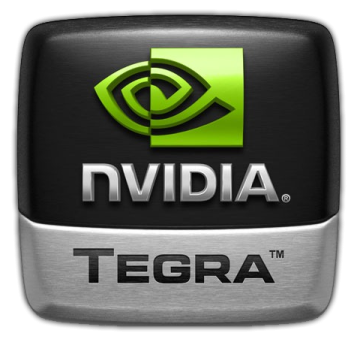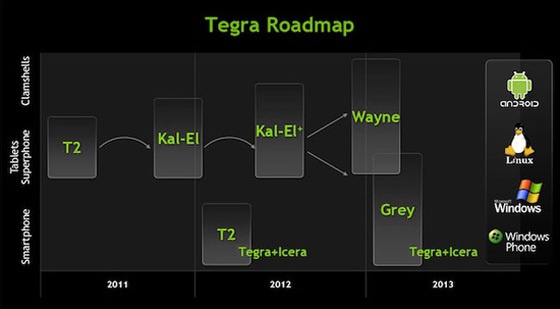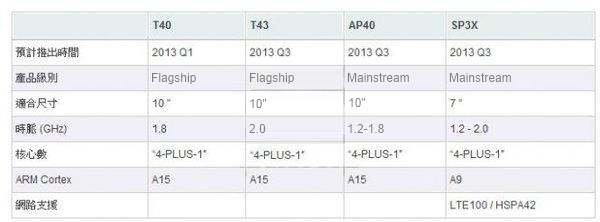Looking Ahead: nVidia and the Tegra SoC, good things to come?

Preface
In the world of personal computers things are quite simple. We have Intel and AMD CPU's paired with Nvidia and AMD GPU's (ok there are others but those are the 3 big players).
However, when it comes to mobile computing the lines get muddier as we are dealing with SoC's (Systems on a Chip).
A SoC is a chipset which combines both elements, CPU & GPU, into a single processor. As fabrication processes get smaller, more and more odds and ends are being included in a single chip. Things like cores devoted specifically to video decoding, 3G, 4G, and even smaller "companion core" (often cortex-A5) CPU cores used to do most "day to day" processing to save battery life. The Tegra 3 is one such device, while it is often referred to as a "quad core" it actually has a fifth low-power companion core.
Whilst we see mobile �CPU's� from companies like Samsung, RockChip and Texas Instruments these can be paired up with different �GPU� elements from companies like ARM (Mali), Vivante (GC series), and PowerVR (SGX series). Interestingly enough, most CPU's are built based on ARM reference designs. For example, the Tegra 3 is a Cortex-A9 reference chip, and the latests Samsung Exynos 5XXX series is Cortex-A15. ARM doesn't fabricate any of its own chipsets. Qualcomm (SnapDragon, Krait, etc.) is the odd man out in that they build chipsets that process ARM code, but are not based on ARM reference designs, thus saving them money. There are even some competing processor architectures out there such as MIPs and now, with Windows 8, x86 is finally making its way to the mobile space with Intel's new Atom Clover Trail processors.
What each manufacturer decides to �blend� into a single SoC will depend on a number of factors including, but not limited to, compatibility, cost, and performance. The general rule of thumb is that the more that can be blended into a single chip, the more efficient it becomes as it drops heat and power consumption. Often, it also lowers the price for the final product.
Nvidia and Qualcomm both differ from the rest slightly in that they make SoC's which use their own brand integral GPU elements. In this article, we are going to focus on Nvidia's current and upcoming offerings.
Tegra
Nvidia�s Tegra 3, T30, quad-core processor has made its way into several high profile devices this year, such as the ASUS Transformer Prime and the Google Nexus 7, so what else can we expect from the company in the future?
As far as this year is concerned, we should see a new version of the Tegra 2 that integrates a Icera 4G LTE baseband (more on the LTE issue later).
The Tegra 2, which is fairly �old tech�, is now mostly limited to lower specification tablets and smart phones which are looking for a simple, lower cost, solution. But by adding 4G capability Nvidia is cleverly extending the products life and we may see a small resurgence of devices taking advantage of this.
We can also expect the new Tegra 3 chip, T35, that is intended to be used, primarily, with Windows 8 RT on ARM powered notebooks and tablets.
While the new Tegra 3 (T35) SoC will not be a die shrink, it will have higher clock speeds (somewhere between 1.6-1.7GHz) due to less restrictions placed on the maximum TDP (thermal design power) allowed for the devices.
Thanks to a leaked "spec sheet/roadmap" we know that the company plans to introduce two new chipsets code named �Grey� and �Wayne�.

It appears that �Grey� will be a dual core 28nm SoC that uses two Cortex A15 CPU cores, a revamped GPU, and an Icera 4G LTE radio (expected to d�but at Mobile World Congress 2013).
Whilst �Wayne� or as it will be better known, Tegra 4, is already in development and can be expected sometime in Q1 of 2013.
�Wayne� has been given the model number T40 and will be comprised of multiple ARM Cortex A15 CPU cores running at 1.8GHz.
This year has seen a big move for smaller silicon manufacturing processes with Intel's 22nm Ivy Bridge, and NVIDIA and AMD both moving to 28nm on their graphics cards, GPU's, for PC's.
Amongst the benefits a smaller die brings are:
- a) Reduced heat generation
- b) Enhanced power usage
- c) Lower price due to lower production costs
- d) Higher clock speeds
All four characteristics are of major importance to a mobile SoC. It appears that Nvidia is also intending to move the Tegra 4 onto a 28nm process.
The remaining Tegra 4 models are expected for Q3 of 2013, but most interesting is the SP3X SoC which not only has the potential to be clocked at speeds of 2.0GHz, but may also come equipped with LTE100/HSPA42.
If proven to be true, this is quite a big step as their current Tegra 3 chips have no support for LTE. In fact it is entirely possible, with the plans to release a Tegra 2 & Tegra 4 WITH LTE support, that the Tegra 3 may never get this functionality.
One of the primary roadblocks that kept the Tegra 3 from getting LTE was the fact that Qualcomm owns the majority of the patents in this area and have refused to deal with Nvidia (no surprise as they are in direct competition with each other).
This has resulted in some high profile manufacturers, like HTC, to swap out the quad-core Nvidia Tegra 3 in favour of Qualcomm�s own Snapdragon S4 chip-set with integrated LTE � clearly a win-win situation for Qualcomm.
